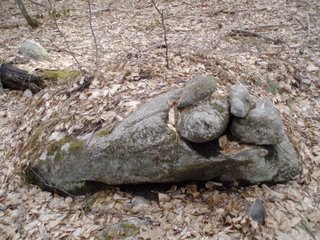 Continuing the description started several posts below, we now walk a few yards over to the spring. This area is enclosed in stone walls which have no entrance. There are numerous small piles, some on the ground but most on or beside a support. Some of these piles look representational.
Continuing the description started several posts below, we now walk a few yards over to the spring. This area is enclosed in stone walls which have no entrance. There are numerous small piles, some on the ground but most on or beside a support. Some of these piles look representational.  For example in this previous one, I see an outline at the lower right part of the pile. Is this just an illusion from the way the leaves are covering it?Many of these piles have been groomed in the past which makes some more visible. This next one has been previously published.
For example in this previous one, I see an outline at the lower right part of the pile. Is this just an illusion from the way the leaves are covering it?Many of these piles have been groomed in the past which makes some more visible. This next one has been previously published.  Needless to say this strikes me as particularly feminine and I believe it is a classic female effigy. Just next to this pile the water comes out of the ground. On the other side of this out-flow, ten feet from the above pile, is this other one which unfortunately looks pretty damaged.
Needless to say this strikes me as particularly feminine and I believe it is a classic female effigy. Just next to this pile the water comes out of the ground. On the other side of this out-flow, ten feet from the above pile, is this other one which unfortunately looks pretty damaged. This next one, seems to be avoiding a similar fate:
This next one, seems to be avoiding a similar fate: I always thought this next one was a representation.
I always thought this next one was a representation.  However attention focuses on the interesting black-and-white rock near the center. Here, take a closer look:
However attention focuses on the interesting black-and-white rock near the center. Here, take a closer look: For reference, there are several interesting rock here. The one to the left, which I think of as a "head". Between it and the black-and-white rock is another interesting shaped rock.
For reference, there are several interesting rock here. The one to the left, which I think of as a "head". Between it and the black-and-white rock is another interesting shaped rock. The spring creates a small valley which opens to the southeast. I believe this is a different kind of site than some others we have seen here. I think some of these piles are effigies. If you are not comfortable using the word "effigy" look at the example below called "Rock pile picture of the week". That is the kind of symmetry I am calling an effigy.
1 comment :
Springs are interesting places in many older cultures around the world--meeting places of the world below and the world above, and often very feminine in landscape and configuration. Often, too, the living things to be found around a spring are different from those in the landscape surrounding. Some cultures have the concept of water being blood or milk that the mother earth offers for the sustenance of thhe living things and people.
Every culture up until the modern one always knew where the springs were, some believed that spirits dwelt there, and many left offerings at certain seasons, or in honor of rites of passage in the lives of women especially.
I know you know this stuff, Peter, but it may be helpful context for anyone who doesn't.
Post a Comment